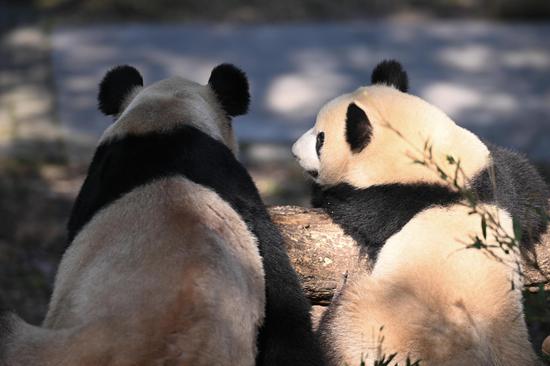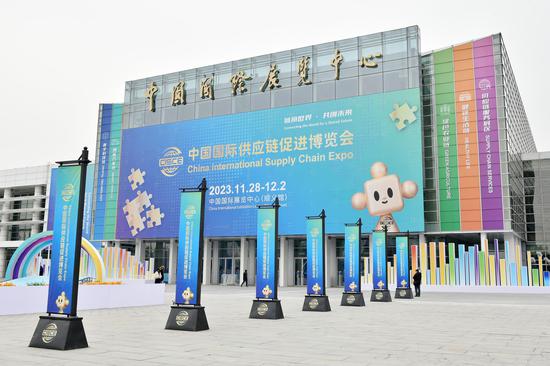
Different flavors of Kweichow Moutai ice cream are displayed at a store in Guangzhou, Guangdong province, in June. (CHEN YIHANG/FOR CHINA DAILY)
The fundamental reasons why time-honored brands launch crossover products include rejuvenating brand recognition, expanding the range of target consumers and enhancing influence, said marketing experts. Here are some successful crossover cases by long-established brands.
Kweichow Moutai
One of China's most prestigious liquor brands, Moutai has a history of more than eight centuries. But rather than rest on its laurels, in the past few years, the nation's top liquor maker has redoubled its efforts to attract younger consumers through a series of crossover products.
In May 2022, three flavors of prepackaged ice cream produced as a joint venture between Kweichow Moutai and dairy producer China Mengniu Dairy Co Ltd hit the shelves, and this September, a mere 12 days after collaborating with domestic coffee chain Luckin Coffee to produce a flavored latte, Kweichow Moutai unveiled a new partnership with Mars Inc's Dove to release liquor-filled chocolate.
The top domestic spirit brand claims some 3.4 million people had purchased Moutai-flavored ice cream as of Dec 29, 2022, with about 400 million people aware of the special ice cream product, the Beijing News reported.
Kweichow Moutai also announced that some 10 million cups of the prepackaged ice cream had been sold by May.
Li Yijun, a senior trends analyst at Mintel, stated these efforts by the time-honored brand have set successful examples for others. She said liquor makers face an uphill battle in attracting the younger generations, but collaboration with the coffee brand will help leverage Moutai's high penetration among young people to expand its target customers.
Nearly half (49.78 percent) of the nation's liquor consumers are aged between 31 and 40, followed by the 18-30 group (39.13 percent), Beijing Business Today reported, citing data collected by iiMedia Research.
White Rabbit
White Rabbit, once a darling of Chinese consumers, has likewise jumped on the crossover wagon and impressed the public with its innovative products in response to customer demands.
White Rabbit creamy candy was first manufactured by Shanghai Guan Sheng Yuan Food in 1959 as a salute from Shanghai industrial workers to the 10th anniversary of the People's Republic of China, but its history can be traced to 1943, when a merchant from the Aipixi Candy Factory was inspired by the taste of a British milk candy.
By 2015, when its product and market share began showing signs of stagnation, White Rabbit started releasing a series of crossover products, and its global partners included Agnes b, the National Museum of China, Pacific Coffee, local fragrance brand Scent Library, Godiva, and SK-II, among others.
One of White Rabbit's most renowned crossover products was a lip balm jointly launched by the candy company and Chinese cosmetics maker Shanghai Jahwa's Maxam in 2018. The first batch of creamy-flavored chapsticks was snapped up in seconds on Maxam's flagship store on Tmall, and 10,000 more were sold within three hours, said Shanghai Guan Sheng Yuan Food.
Another well-known crossover by White Rabbit took place in November 2022 at the fifth China International Import Expo in Shanghai, with US-based luxury company Tapestry's Coach. Their collaboration launched a global line of fashion products, including apparel, handbags, footwear and children's wear imprinted with the iconic White Rabbit logo. A second series of crossover products was launched by the two brands in July this year, according to Tapestry, and the marshmallow pink bags with the White Rabbit logo proved to be a popular gift choice for Chinese Valentine's Day.
Thanks to the company's creative crossover products, White Rabbit's image has continued to reach expanded target consumers and further boosted sales of the creamy candy. During the Chinese New Year season between December 2022 and January 2023, the company achieved sales revenue of 400 million yuan ($56 million), accounting for one-third of its annual total, according to Shanghai Securities News.
"Cooperation between the two brands combines childhood memories and a sense of nostalgia inspired by the White Rabbit logo and Tapestry's sense of fashion brand," Li said.
The Palace Museum
The more than 600-year-old Palace Museum is a pioneer in terms of offering creative crossover products and building a younger, fresher image.
"The Forbidden City is old enough to make most prestigious brands with a long history look young, but regarding all the crossover products it has created in recent years, the Palace Museum is seen more as cute and fun," said Ma Jun, vice-president of the Shanghai Time-honored Brand Association and general manager of Shanghai Lifengfood Co Ltd.
Ranging from calendars and souvenirs to makeup, clothes, accessories and food products, the Forbidden City has become a role model in offering cultural and creative products that can be used in daily life. More than 11,000 cultural and creative products had been researched and developed as of December 2018, and related products generated 1.5 billion yuan in sales revenue, People's Daily reported.
Across the great spectrum of products, Palace Museum-themed lipsticks and a makeup series including eye shadow and blush have been extremely successful. During the four-day pre-sale period, more than 90,000 lipsticks were sold, according to the Beijing News report.
"To my understanding, the products must be researched and developed based on people's needs; in the meantime, there must be constant efforts made in digging deep into cultural resources," Shan Jixiang, former director of the Palace Museum, told the Beijing News.
"The collection of the Forbidden City presents an inexhaustible treasure, which allows us to constantly exploit, conduct innovations and create cultural and creative products adored by the people. This is an absolute advantage for us," Shan added.
China's time-honored brands reported a combined sales revenue of more than 1.2 trillion yuan in 2022, with some 70 percent of them staying profitable, said a report on Chinese time-honored brands' development published during the sixth China International Import Expo in early November.
By recruiting a total of 872,000 people, the age-old brands' tax contribution amounted to 270 billion yuan. Their growth tendency has continued this year, with sales revenue in the first three quarters having already surpassed the whole year amount of last year, the report said.
Benefiting from the continued recovery of consumption, China's time-honored brands have seen a vigorous growth momentum through innovations and development, added the report.


















































 京公网安备 11010202009201号
京公网安备 11010202009201号